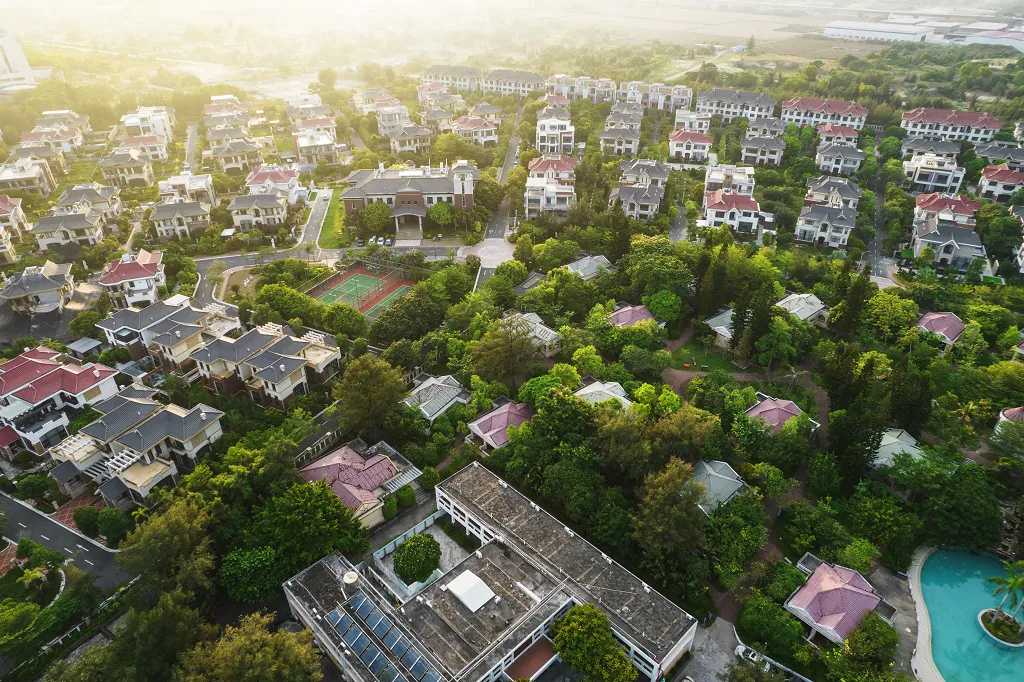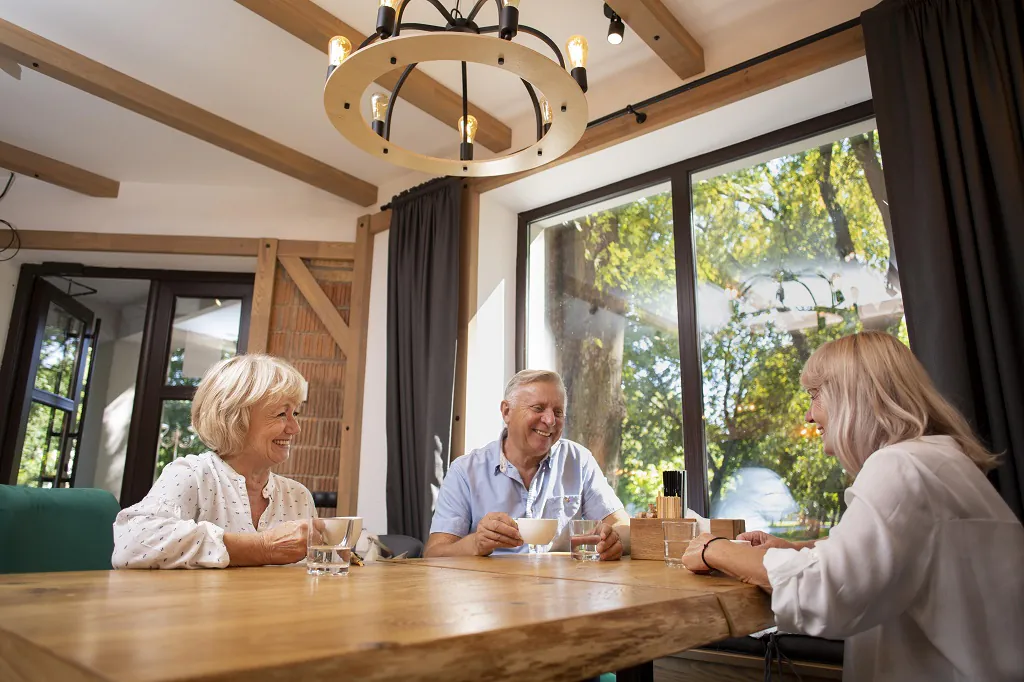Horizontal Apartments: 10 Unbeatable Advantages

In the ever-evolving landscape of real estate, horizontal apartments have carved a unique niche. These living spaces, characterized by their sprawling, low-rise design, offer a distinct blend of community living and personal space. This article will delve into the world of horizontal apartments, exploring their history, benefits, challenges, and much more.
Table of Contents
What are Horizontal Apartments?
Definition and Explanation
Horizontal apartments, also known as garden apartments or low-rise apartments, are residential buildings that typically have only one or two stories. Unlike traditional high-rise apartments that extend vertically, horizontal apartments are spread out horizontally across the land, hence the name. They are designed to maximize the use of space, offering residents a blend of private and communal areas.
These apartments are often arranged around a central courtyard or garden, which serves as a communal area for residents. This design promotes a sense of community among residents, while also providing each apartment with its own private outdoor space. The apartments themselves are typically self-contained units with their own entrances, much like individual houses.
The History and Evolution of Horizontal Apartments
The concept of horizontal apartments dates back to the early 20th century, during a time when urban populations were rapidly increasing and there was a growing need for affordable housing. The idea was to create a type of housing that combined the benefits of both houses and apartments.
Horizontal apartments were designed to offer the space and privacy of a house, along with the affordability and community living of an apartment. They were initially popular in suburban areas, where land was more readily available. However, with the increasing demand for housing in urban areas, they have also become popular in cities.
Over the years, horizontal apartments have evolved to incorporate modern amenities and design aesthetics. Today, they come in various styles and sizes, from luxury complexes with high-end amenities to affordable housing options for low-income families. Despite these changes, the core concept of horizontal apartments remains the same – to provide a balance between private and communal living in a low-rise setting.
Benefits of Horizontal Apartments

| Benefits | Description | Examples |
|---|---|---|
| Space Utilization | More personal outdoor space | Private gardens, patios |
| Community Living | Close-knit community | Communal areas, events |
| Amenities and Facilities | Modern amenities | Pools, gyms, clubhouses |
| Privacy | More privacy than high-rises | Spread out over a larger area |
| Accessibility | Easier access for those with mobility issues | Fewer stairs, more ground-level access |
| Natural Light | More natural light than vertical apartments | Larger windows, fewer obstructions |
| Lower Noise Levels | Less noise from neighbors | Spread out over a larger area |
| Pet-Friendly | More accommodating for pet owners | Outdoor space for pets |
| Lower Impact from Neighbors | Fewer disturbances from neighbors | Fewer shared walls and floors |
| Design Flexibility | More flexibility in interior design | Customizable layouts, personal touches |
Horizontal apartments offer a unique blend of benefits that cater to a wide range of lifestyle needs. Here are the top 10 benefits of choosing a horizontal apartment:
- Space Utilization: Horizontal apartments are known for their efficient use of space. They often come with private gardens or patios, providing residents with their own outdoor space.
- Community Living: These apartments are often designed around a communal area, promoting a sense of community among residents.
- Amenities and Facilities: Many horizontal apartment complexes come with modern amenities like pools, gyms, and clubhouses.
- Privacy: Despite the communal setting, horizontal apartments offer more privacy than high-rise buildings as they are spread out over a larger area.
- Accessibility: With fewer stairs and more ground-level access, horizontal apartments are often more accessible for people with mobility issues.
- Natural Light: Due to their design, horizontal apartments often receive more natural light than vertical apartments.
- Lower Noise Levels: As they are spread out, noise from neighbors is often less of an issue in horizontal apartments.
- Pet-Friendly: With more outdoor space, horizontal apartments are often more accommodating for pet owners.
- Lower Impact from Neighbors: With fewer shared walls and floors, disturbances from neighbors are often less in horizontal apartments.
- Design Flexibility: Horizontal apartments often offer more flexibility in terms of interior design and layout.
Challenges of Horizontal Apartments

While horizontal apartments offer a unique blend of benefits, they also come with certain challenges. Here are some of the potential drawbacks and how they can be overcome:
- Higher Maintenance Costs: Due to their spread-out nature, horizontal apartments often require more maintenance than vertical apartments. This includes the upkeep of outdoor spaces and communal areas. However, these costs are usually shared among the residents, and many find the benefits of having these spaces worth the extra cost.
- Privacy Concerns: While horizontal apartments offer more privacy than high-rise buildings, they can still have issues. For example, ground-floor apartments may face the street or communal areas, which can lead to a lack of privacy. This can be mitigated by using curtains, blinds, or privacy screens, and by carefully considering the location of the apartment within the complex.
- Limited Vertical Space: Unlike vertical apartments, horizontal apartments do not offer the option of adding more floors to create additional living space. This can be a limitation for those who prefer multi-level living. However, many people find that the benefits of single-level living, such as easier accessibility and maintenance, outweigh this drawback.
- Land Use: Horizontal apartments require more land than vertical apartments, which can be a challenge in densely populated urban areas where land is scarce and expensive. However, they are an excellent option in suburban or rural areas where land is more readily available.
- Potential for Noise: While horizontal apartments are generally quieter than high-rise buildings, noise can still be an issue, especially in apartments that face communal areas or busy streets. This can be mitigated by using soundproofing materials and by carefully considering the location of the apartment within the complex.
Despite these challenges, many people find that the benefits of horizontal apartments outweigh the drawbacks. With careful planning and consideration, these challenges can be effectively managed, making horizontal apartments an excellent housing option for many people.
Comparing Horizontal Apartments with Vertical Apartments
When it comes to choosing between horizontal and vertical apartments, the decision often boils down to personal preference and lifestyle needs. Here’s a comparison of the two:
- Design and Space: Horizontal apartments are spread out over a larger area and often come with private outdoor spaces, such as gardens or patios. On the other hand, vertical apartments are stacked on top of each other, offering more living space in a smaller footprint.
- Community Living: Both types of apartments offer community living, but the experience can be different. Horizontal apartments often have communal outdoor spaces that promote interaction among residents, while vertical apartments may have shared indoor facilities like gyms or lounges.
- Privacy: Horizontal apartments typically offer more privacy than vertical apartments, as they have fewer shared walls and floors. However, ground-floor apartments may face privacy issues if they overlook communal areas or the street.
- Accessibility: Horizontal apartments are generally more accessible, with fewer stairs and more ground-level access. This can be a significant advantage for people with mobility issues. In contrast, vertical apartments may require the use of elevators or stairs.
- Maintenance: Maintenance can be higher in horizontal apartments due to the upkeep of outdoor spaces and communal areas. In contrast, vertical apartments may have lower maintenance costs but higher association fees to cover the maintenance of shared facilities.
Here’s a comparison chart summarizing these points:
| Factors | Horizontal Apartments | Vertical Apartments |
|---|---|---|
| Design and Space | Spread out over a larger area, often with private outdoor spaces | More living space in a smaller footprint |
| Community Living | Communal outdoor spaces that promote interaction | Shared indoor facilities like gyms or lounges |
| Privacy | More privacy due to fewer shared walls and floors | Less privacy due to more shared walls and floors |
| Accessibility | More accessible with fewer stairs and more ground-level access | Less accessible due to the use of elevators or stairs |
| Maintenance | Higher maintenance costs due to the upkeep of outdoor spaces | Lower maintenance costs but higher association fees for shared facilities |
In conclusion, both horizontal and vertical apartments have their own unique advantages and disadvantages. The choice between the two will depend on your personal preferences, lifestyle needs, and budget.
Buying Guide for Horizontal Apartments

When buying a horizontal apartment, there are several key factors to consider. These include the location, the layout of the apartment, the available amenities, and the reputation of the builder. Here’s a detailed guide to help you make an informed decision:
- Location: The location of the apartment complex is crucial. Consider its proximity to essential amenities like schools, hospitals, grocery stores, and public transportation. Also, consider the neighborhood’s safety, cleanliness, and noise levels.
- Layout and Design: Look at the layout of the apartment and the complex. Does it meet your needs and preferences? Do you have enough privacy? Is there enough natural light? Is there outdoor space?
- Amenities: Check what amenities the complex offers. These could include a pool, gym, clubhouse, children’s play area, and parking facilities. Also, consider the maintenance costs for these amenities.
- Builder’s Reputation: Research the builder’s reputation. Look at their past projects, their financial stability, and reviews from previous buyers. This can give you an idea of the quality of construction and the builder’s reliability.
- Legal Considerations: Ensure that the property has all the necessary legal approvals and that the builder has the rights to the land. Also, check the terms of the sale agreement and understand your rights and responsibilities as a buyer.
- Price: Compare the price of the apartment with other similar properties in the area. Ensure that the price is fair and that you are getting good value for your money.
- Future Value: Consider the potential future value of the property. Is the area likely to develop in the future? Are there any upcoming infrastructure projects that could increase the property’s value?
- Home Inspection: Before finalizing the purchase, consider getting a home inspection. This can help identify any potential issues with the property that might not be immediately apparent.
Buying a horizontal apartment is a significant investment, and it’s essential to do thorough research before making a decision. Consider your lifestyle needs, your budget, and the potential future value of the property. And remember, it’s always a good idea to seek professional advice if you’re unsure.
Investment Opportunities in Horizontal Apartments

With the growing popularity of horizontal apartments, they present a promising investment opportunity. Here are some key points to consider:
- Market Trends: The demand for horizontal apartments is on the rise, especially in suburban areas and cities with space constraints. This growing demand can lead to an increase in property values, making horizontal apartments a potentially profitable investment.
- Rental Income: Horizontal apartments can provide a steady source of rental income. They are particularly appealing to renters who desire the community feel of an apartment complex and the privacy and outdoor space of a standalone home.
- Appreciation Potential: Due to their unique blend of benefits, horizontal apartments often have good appreciation potential. Factors such as location, amenities, and the overall quality of the complex can contribute to the property’s value over time.
- Diversification: Investing in horizontal apartments can be a good way to diversify your real estate portfolio. They offer a different set of benefits and risks compared to other types of properties, helping to spread risk.
- Future Developments: Keep an eye on future developments in the area, such as new infrastructure or amenities. These can increase the demand for housing and potentially boost the value of your investment.
- Tax Benefits: Depending on your location, you may be eligible for tax benefits associated with property investment. These can include deductions for mortgage interest, property taxes, and maintenance costs.
Remember, while horizontal apartments can be a good investment, it’s important to do thorough research and consider your financial situation and investment goals. It may also be beneficial to consult with a real estate professional or financial advisor to ensure you’re making the best decision for your circumstances.
Maintenance and Management of Horizontal Apartments
Maintaining a horizontal apartment involves regular upkeep of both the interior and exterior spaces. Here are some key points to consider:
- Interior Maintenance: This includes regular cleaning, as well as the upkeep of appliances, plumbing, and electrical systems. Regular inspections can help identify potential issues before they become major problems.
- Exterior Maintenance: The exterior maintenance of a horizontal apartment can be more extensive than that of a vertical apartment. This can include landscaping, cleaning of outdoor spaces, and maintenance of the building’s exterior.
- Communal Area Maintenance: In a horizontal apartment complex, the maintenance of communal areas is typically the responsibility of the homeowners association or property management company. This can include the upkeep of gardens, pools, gyms, and other shared facilities.
- Building Maintenance: Regular building maintenance is crucial to ensure the longevity of the property and the safety of its residents. This can include everything from roof repairs to pest control. A well-planned building maintenance schedule can help ensure that all necessary tasks are carried out in a timely manner.
- Homeowners Association: In many horizontal apartment complexes, a homeowners association (HOA) is responsible for the management and maintenance of the property. The HOA collects fees from residents to cover these costs. It’s important to understand the role of the HOA and your responsibilities as a resident.
- Dispute Resolution: In a community living setting, disputes can sometimes arise between residents. It’s important to have a clear understanding of the dispute resolution process, which is typically outlined in the HOA’s rules and regulations.
The maintenance and management of a horizontal apartment require regular attention and effort. However, with a well-planned maintenance schedule and a proactive approach, it’s possible to keep your property in excellent condition and ensure a pleasant living environment for all residents.
Success Stories and Case Studies
There are numerous success stories of individuals and families who have found their perfect home in a horizontal apartment. Here are a few examples:
The Young Family

The Young family moved into a horizontal apartment complex in the suburbs after the birth of their second child. They were drawn to the community feel of the complex and the outdoor space for their children to play. Over the years, they have formed close relationships with their neighbors and have become active members of the homeowners association. They love the balance of privacy and community that their horizontal apartment offers.
The Retiree

After retiring, Mrs. Smith decided to downsize from her large family home to a more manageable living space. She chose a horizontal apartment for its accessibility and low maintenance. She enjoys having her own private garden where she can pursue her passion for gardening, and she appreciates the sense of security that comes from living in a close-knit community.
The Investor

Mr. Johnson, a real estate investor, saw the potential in horizontal apartments early on. He invested in several units in a newly built complex, attracted by the growing demand for this type of housing. Over the years, he has seen a significant return on his investment through rental income and property appreciation.
The First-Time Homebuyer
As a first-time homebuyer, Ms. Davis was looking for an affordable housing option that didn’t compromise on space or amenities. She found the perfect fit in a horizontal apartment. She loves the modern design of her apartment and the communal facilities like the pool and gym. She also appreciates the sense of community in the complex.
These success stories highlight the diverse appeal of horizontal apartments. Whether you’re a young family, a retiree, an investor, or a first-time homebuyer, horizontal apartments offer a unique blend of benefits that can meet a wide range of housing needs.
Conclusion
In conclusion, horizontal apartments offer a unique blend of community living and personal space, making them an appealing choice for a wide range of individuals and families. They present a promising investment opportunity and are an excellent choice for those seeking a balance between urban and suburban living.
From their history and evolution to their benefits and challenges, we’ve delved into various aspects of horizontal apartments. We’ve compared them with vertical apartments, provided a buying guide, and shared success stories of people who have made these apartments their homes.
While they may not be the perfect fit for everyone, horizontal apartments certainly have a lot to offer. They are a testament to the creativity and adaptability of the real estate industry, offering a unique solution to the challenges of urban living.
Whether you’re considering buying a horizontal apartment for yourself or as an investment, we hope this guide has provided you with valuable insights to help you make an informed decision. Remember, the most important thing is to choose a home that fits your lifestyle, meets your needs, and makes you feel comfortable and happy.